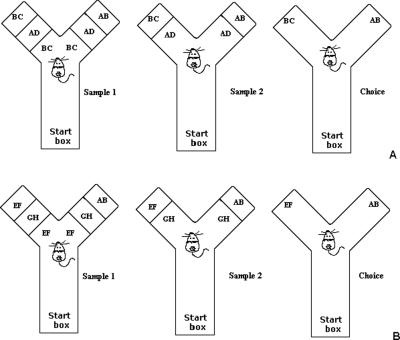Figure 2.
(A) Illustration of the configural condition of the zero-delay object recognition tasks. Each test session consisted of three phases: sample 1, sample 2, and a choice phase. All object sets used in a given trial were placed in the apparatus before the rat was placed in the start box. The rat was then placed in the start box with the guillotine door lowered. The guillotine door was then raised to allow the rat into the exploration area of the apparatus. When the rat exited the start box, the guillotine door was lowered to prevent re-entry, and the test phases began. When the rat exited the start box, the duplicate sample 1 objects (possible sample objects, BC and AD, were counterbalanced within and between groups as either sample 1 or 2; this illustration depicts a trial where BC was presented in sample 1 and AD was presented in sample 2) were revealed to the rat. Sample 1 ended when the rat had explored the identical objects for 25 sec. Upon completion of exploration of sample 1 stimuli, the sample 1 stimuli were removed, the door was opened between sample 1 and sample 2, and the rat was immediately shown the sample 2 (AD) stimuli. Upon completing sample 2, the stimuli were removed, the door between sample 2 and choice was opened, and the novel (AB) and familiar (BC) stimuli were immediately presented to the rat in the choice phase. (B) Illustration of the control condition of the zero-delay object recognition task. The control condition was identical to the configural condition except that the sample stimuli EF and GH were counterbalanced within and between groups as sample 1 and sample 2, and the novel stimulus AB was the novel stimulus (this was not the same stimulus AB used during the configural condition).

